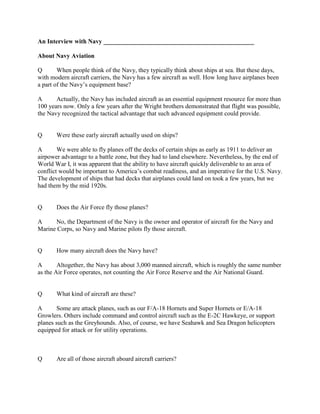
Aviation
- 1. An Interview with Navy ________________________________________________ About Navy Aviation Q When people think of the Navy, they typically think about ships at sea. But these days, with modern aircraft carriers, the Navy has a few aircraft as well. How long have airplanes been a part of the Navy’s equipment base? A Actually, the Navy has included aircraft as an essential equipment resource for more than 100 years now. Only a few years after the Wright brothers demonstrated that flight was possible, the Navy recognized the tactical advantage that such advanced equipment could provide. Q Were these early aircraft actually used on ships? A We were able to fly planes off the decks of certain ships as early as 1911 to deliver an airpower advantage to a battle zone, but they had to land elsewhere. Nevertheless, by the end of World War I, it was apparent that the ability to have aircraft quickly deliverable to an area of conflict would be important to America’s combat readiness, and an imperative for the U.S. Navy. The development of ships that had decks that airplanes could land on took a few years, but we had them by the mid 1920s. Q Does the Air Force fly those planes? A No, the Department of the Navy is the owner and operator of aircraft for the Navy and Marine Corps, so Navy and Marine pilots fly those aircraft. Q How many aircraft does the Navy have? A Altogether, the Navy has about 3,000 manned aircraft, which is roughly the same number as the Air Force operates, not counting the Air Force Reserve and the Air National Guard. Q What kind of aircraft are these? A Some are attack planes, such as our F/A-18 Hornets and Super Hornets or E/A-18 Growlers. Others include command and control aircraft such as the E-2C Hawkeye, or support planes such as the Greyhounds. Also, of course, we have Seahawk and Sea Dragon helicopters equipped for attack or for utility operations. Q Are all of those aircraft aboard aircraft carriers?
- 2. A Well, aircraft carriers certainly are a principal mode of delivery and readiness, but the Navy maintains air bases on land as well, and other ships these days will also have deck capacity for certain aircraft, especially helicopters. Q Are all of these aircraft focused on delivering firepower to an enemy? A No, that is not always the case. As a global force for good, the Navy does a lot more than deliver defensive power to keep aggression in check. We also deliver humanitarian aid to regions that need it, such as the Japanese coast following the tsunami a short time ago, or Haiti following their earthquake, or our own gulf coast after hurricane Katrina. We also conduct sea search and rescue missions around the world. Q It probably requires a lot of pilots to support these air operations, doesn’t it? A Pilots only make up a small portion of the manpower requirement. A typical air wing is comprised of a complement of 2500+ people. This includes aircraft maintenance people ranging from mechanics and electricians to radar specialists, electronics experts and air controllers. What’s more, we need to have air rescue swimmers, helicopter crew personnel and weapons specialists as well. Q How does one get started pursuing this opportunity? A Actually, the best first step is to contact the local recruiting station to find out about any and all of the jobs that we have available. To reach us, simply contact our station by calling ______________, or stop in most afternoons at ___________________________________. If you or an out of-town friend want to locate another station near them, visit www.navy.com and click on “find a recruiter” on the right side of the home page, then enter your zip code number. The website will identify contact locations for both enlisted and officer programs. A call to 800- 4go –Navy will do the trick as well. Additional comment: To put the Navy’s role in perspective, you need to recognize that 70 percent of the world is covered by ocean, 80 percent of the world’s population lives along coasts and 90 percent of the world’s commerce travels by water. Protecting all of that is our job, and that makes America’s Navy a global force for good. Sailors serve on land and from the sea; from ships on the water, submarines under the water, and planes and helicopters over the water – all to meet America’s threats far away so that those threats cannot harm us here. We welcome the best men and women to join us in accomplishing today’s missions and meeting tomorrow’s challenges.
- 3. - 30 -
